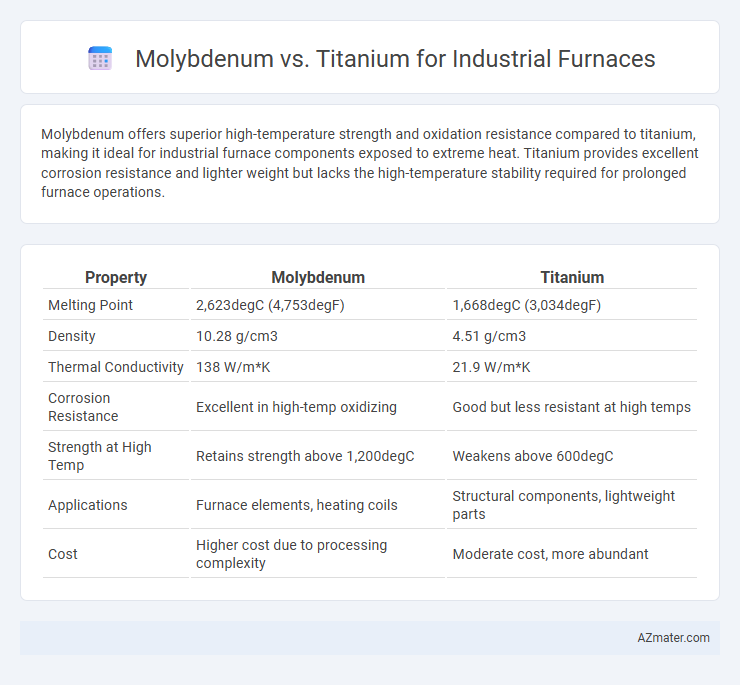Molybdenum offers superior high-temperature strength and oxidation resistance compared to titanium, making it ideal for industrial furnace components exposed to extreme heat. Titanium provides excellent corrosion resistance and lighter weight but lacks the high-temperature stability required for prolonged furnace operations.
Table of Comparison
| Property | Molybdenum | Titanium |
|---|---|---|
| Melting Point | 2,623degC (4,753degF) | 1,668degC (3,034degF) |
| Density | 10.28 g/cm3 | 4.51 g/cm3 |
| Thermal Conductivity | 138 W/m*K | 21.9 W/m*K |
| Corrosion Resistance | Excellent in high-temp oxidizing | Good but less resistant at high temps |
| Strength at High Temp | Retains strength above 1,200degC | Weakens above 600degC |
| Applications | Furnace elements, heating coils | Structural components, lightweight parts |
| Cost | Higher cost due to processing complexity | Moderate cost, more abundant |
Introduction to Molybdenum and Titanium
Molybdenum and titanium are critical metals used in industrial furnace applications due to their exceptional high-temperature strength and corrosion resistance. Molybdenum exhibits a high melting point of 2,623degC and excellent thermal conductivity, making it ideal for furnace components exposed to extreme heat. Titanium offers a lower density with a melting point of 1,668degC, providing strength and oxidation resistance while reducing overall weight in furnace parts.
Material Properties Overview
Molybdenum offers exceptional high-temperature strength and thermal conductivity, making it ideal for industrial furnace components exposed to extreme heat and thermal cycling. Titanium provides superior corrosion resistance and a high strength-to-weight ratio but has lower thermal stability compared to molybdenum at elevated temperatures. The choice between molybdenum and titanium depends on specific furnace operating conditions, with molybdenum favored for environments requiring sustained high-temperature durability and titanium suited for applications where corrosion resistance and weight savings are critical.
High-Temperature Performance Comparison
Molybdenum exhibits superior high-temperature strength and oxidation resistance up to 1,200degC, making it ideal for furnace components exposed to extreme heat. Titanium, while strong and lightweight, loses strength rapidly above 600degC and suffers from oxidation without protective atmospheres, limiting its use in high-temperature furnace applications. The thermal stability and creep resistance of molybdenum outperform titanium, ensuring longer service life and reliability under severe industrial furnace conditions.
Corrosion and Oxidation Resistance
Molybdenum exhibits superior corrosion resistance in reducing atmospheres and high-temperature oxidation environments up to approximately 1000degC, making it ideal for industrial furnace components exposed to such conditions. Titanium offers exceptional resistance to oxidation in oxidizing environments below 600degC but forms brittle oxides at higher temperatures, limiting its effectiveness in intense furnace atmospheres. Choosing molybdenum over titanium enhances durability and lifespan in high-temperature, corrosive industrial furnace settings due to its robust oxidation resistance and stability.
Mechanical Strength and Durability
Molybdenum offers exceptional mechanical strength at high temperatures, maintaining stability up to 1,200degC, which is crucial for industrial furnace components exposed to extreme heat. Titanium, while strong and lightweight, tends to lose mechanical strength above 600degC, limiting its durability in high-temperature industrial environments. The superior high-temperature strength and oxidation resistance of molybdenum make it more suitable for furnace parts requiring long-term durability under intense thermal stress.
Thermal Conductivity and Heat Resistance
Molybdenum exhibits superior thermal conductivity, approximately 138 W/m*K, which allows efficient heat distribution in industrial furnaces, reducing hot spots and enhancing thermal stability. Titanium, with a lower thermal conductivity around 22 W/m*K, offers excellent heat resistance and oxidation stability at moderately high temperatures but is less effective for rapid heat transfer. Molybdenum's high melting point of 2623degC and outstanding heat resistance make it ideal for extreme temperature applications, whereas titanium's melting point near 1668degC suits less demanding thermal environments.
Cost Effectiveness and Availability
Molybdenum offers high cost-effectiveness due to its excellent strength and corrosion resistance at elevated temperatures, making it ideal for industrial furnace components operating in harsh environments. Titanium, while highly corrosion-resistant and lightweight, has higher raw material and processing costs, reducing its cost efficiency in furnace applications. Molybdenum's broader availability and established supply chains further enhance its economic advantages compared to titanium in industrial furnace manufacturing.
Fabrication and Machinability
Molybdenum offers superior high-temperature strength and excellent thermal conductivity, making it ideal for industrial furnace components requiring precise fabrication and minimal thermal expansion. Titanium provides outstanding corrosion resistance and a favorable strength-to-weight ratio, but its machining is more challenging due to its tendency to gall and require specialized tooling. For fabrication, molybdenum's machinability is moderate, benefiting from its ductility at elevated temperatures, while titanium demands slower machining speeds and careful heat management to prevent work hardening.
Common Industrial Furnace Applications
Molybdenum and titanium are crucial materials in industrial furnace applications, with molybdenum prized for its high melting point and excellent thermal conductivity, ideal for furnace components exposed to extreme heat such as heating elements and structural supports. Titanium offers superior corrosion resistance and strength-to-weight ratio, making it suitable for furnace parts operating in corrosive environments or requiring lightweight but durable materials. Common applications include heat exchangers, furnace linings, and protective coatings where the choice between molybdenum and titanium depends on temperature requirements and chemical exposure.
Choosing the Right Material for Your Furnace
Molybdenum offers excellent high-temperature strength and thermal conductivity, making it ideal for furnace components exposed to extreme heat and rapid temperature cycling. Titanium provides superior corrosion resistance and lower density, which benefits applications requiring weight savings and enhanced durability in aggressive environments. Selecting between molybdenum and titanium for industrial furnaces depends on prioritizing thermal performance versus corrosion resistance, alongside cost considerations and specific operational conditions.

Infographic: Molybdenum vs Titanium for Industrial Furnace
 azmater.com
azmater.com